Resistor color codeWhat is a resistor?The resistor is an electronic component that provides electrical resistance. It also acts as a protection device in a circuit. The resistor's role includes reducing current flow, operation, adjusting signal levels, and dividing the voltage. The SI unit of resistance is Ohm. It means the amount of the resistance given by the resistor is measured in Ohms. SI unit is a French word and is generally known as System International of Units. ResistanceResistance is termed as the electrical resistance of a resistor, which is measured in Ohms. The value of resistance can vary from few to large. The resistors are used in various applications ranging from small circuit boards to large circuits. It includes amplifiers, oscillators, transmitters, generators, millimeters, modulators, etc. Why we require resistor color coding?The value of the resistance is not printed on any resistor. Hence, the knowledge of resistor color code is essential to determine the value of the resistance. It is also used to predict the tolerance of a resistor. Every resistor has unique combinations of the color bands. The resistor color coding is an easy method to find the resistance value quickly. Every circuit has its limitations of resistance. It is essential to use a resistor according to the high or low required resistance value. Let's first discuss the parameters that are used to determine the value of the resistance. ParametersFour parameters determine the resistance of a resistor. The four parameters are color, digit, multiplier, and tolerance, responsible for the formation of hundreds or millions of different types of resistors. The fifth parameter (TCR) is only required to find a six-color band resistor's resistance value. Each resistor has a unique combination of these parameters with the resistance value. BandsBands specify the colors on the resistor. The four-color lines on a resistor specify the four bands. Similarly, five color lines define the five bands. The color bands are used to determine the value of the resistance. There are three, four, five, or six color bands in a resistor. Let's discuss how to find the resistance value of all these different types of resistor color bands. 3 color bandsThere are three parameters required to find the resistance value of a 3 color band resistor. DigitWe know that the available number of digits is 0, 1, 2, 3, 4, 5, 6, 7, 8, and 9. It means that 10 digits are responsible for the infinite number formation. ColorSimilarly, there are 10 colors for the 10 digits. The colors marked on the resistors will be among these 10 colors only. We will match the marked color with the number, which helps us determine the resistance value. MultiplierMultiplier=10n Where n = digit Multiplier refers to the resistance value multiplied with 10^n. For n = 0, Multiplier=100=1 For n = 1, Multiplier=101=10 For n = 2, Multiplier=102=100 Similarly, the value of the multiplier can be calculated for all 10 digits. The first two color bands signify the digit at tens and one place. The color value of the third band refers to the value as a multiplier. Format of resistance The value of the electrical resistance of a resistor will be in the format: ab×Multiplier=ab×10n Where, a = Digit of the first corresponding color band on the resistor b = Digit of the second corresponding color band on the resistor n = Digit of the third corresponding color on the resistor The table for these 10 colors is shown below:
The Tolerance value is not required for 3 color band. We will discuss the tolerance term for 4, 5, and 6 color bands. Let's understand the 3 color bands resistor color code with the help of few examples. Example 1: Consider the below resistor: 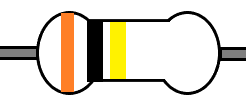
a = 3 (Orange) b = 0 (Black) n = 4 (Yellow) We know the value of resistance can be calculated as: ab×Multiplier=ab×10n 30×104=300000Ohms=0.3MΩ Example 2: Consider the below resistor: 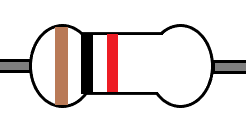
a = 1 (Brown) b = 0 (Black) n = 2 (Red) The value of resistance can be calculated as: ab×Multiplier=ab×10n 10×102=1000Ohms=1KΩ Example 3: Consider the below resistor: 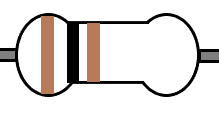
a = 1 (Brown) b = 0 (Black) n = 1 (Brown) The value of resistance can be calculated as: ab×Multiplier=ab×10n 10×101=100Ohms=0.1KΩ Example 4: Consider the below resistor: 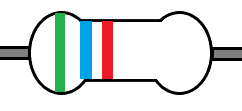
a = 5 (Green) b = 6 (Blue) n = 2 (Red) The value of resistance can be calculated as: ab×Multiplier=ab×10n 56×102=5600Ohms=5.6KΩ 4 color bandsThere are four parameters required to find the resistance value of a 4 color band resistor. DigitThe available numbers of digits are 0, 1, 2, 3, 4, 5, 6, 7, 8, and 9. ColorSimilarly, there are 10 colors for the 10 digits. Note: The number of digits and colors are fixed for all the types of color bands.MultiplierMultiplier=10n Where n = digit Multiplier refers to the resistance value multiplied with 10^n. ToleranceThe Tolerance is expressed as the minus or plus value. It is defined as the difference between the two values, i.e., actual and required. We can also say that tolerance is the error percentage in a resistor. Note: If there is no color band, the tolerance value is assumed as 20%.Format of resistance The first two color bands signify the digit at tens and one place. The color value of the third band refers to the value as a multiplier. The fourth band determines the tolerance of a resistor. The value of electrical resistance of a 4 color band resistor will be in the format: ab×Multiplier±Tolerance=ab×10n±Tolerancevalue The table is shown below:
Let's understand the 4 color bands resistor color code with the help of few examples. Example 1: Consider the below resistor: 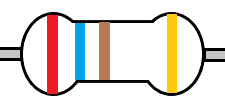
a = 2 (Red) b = 6 (Blue) n = 1 (Brown) Tolerance = 5% (Golden) The value of resistance can be calculated as: ab×Multiplier±Tolerance 26×101±5%=260Ohms±5% 0.26KΩ±5% Example 2: Consider the below resistor: 
a = 2 (Red) b = 5 (Green) n = 3 (Orange) Tolerance = 10% (Silver) The value of resistance can be calculated as: ab×Multiplier±Tolerance 25×103±10%=25000Ohms±10% 25KΩ±10% The format of 5 and 6 color bands is different from 3 and 4 color band resistors. 5 color bandsThere are four parameters required to find the resistance value of a 4 color band resistor. DigitThe available numbers of digits are 0, 1, 2, 3, 4, 5, 6, 7, 8, and 9. ColorSimilarly, there are 10 colors for the 10 digits. MultiplierMultiplier=10n Where, n = digit ToleranceThe Tolerance is expressed as the minus or plus value. It is defined as the difference between the two values, i.e. actual and required. We can also say that the tolerance is the error percentage in a resistor. Format of resistance The first three-color bands signify the digit at hundreds, tens, and one place. The color value of the fourth band refers to the value as a multiplier. The fifth band determines Tolerance of a resistor. The value of electrical resistance of a 4 color band resistor will be in the format: abc×Multiplier±Tolerance=abc×10n±Tolerancevalue Where, a = Digit of the first corresponding color band on the resistor b = Digit of the second corresponding color band on the resistor c = Digit of the third corresponding color band on the resistor n = Digit of the fourth corresponding color on the resistor The table is shown below:
Let's understand the 5 color bands resistor color code with the help of few examples. Example 1: Consider the below resistor: 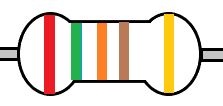
a = 2 (Red) b = 5 (Green) c = 3 (Orange) n = 1 (Brown) Tolerance = 5% (Golden) The value of resistance can be calculated as: abc×Multiplier±Tolerance 253×101±5%=2530Ohms±5% 2.53KΩ±5% Example 2: Consider the below resistor: 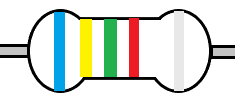
a = 6 (Blue) b = 4 (Yellow) c = 5 (Green) n = 2 (Red) Tolerance = 10% (Silver) The value of resistance can be calculated as: abc×Multiplier±Tolerance 645×102±10%=64500Ohms±10% 64.5KΩ±10% 6 color bandsThe 6 color band resistor includes five parameters as compared to the above 3, 4, and 5 color bands. The fifth parameter is temperature coefficient resistance (TCR). TCR is expressed in ppm/C (parts per million per degree Centigrade). The other four parameters are the same. DigitThe available numbers of digits are 0, 1, 2, 3, 4, 5, 6, 7, 8, and 9. ColorSimilarly, there are 10 colors for the 10 digits. MultiplierMultiplier=10n Where, n = digit ToleranceThe Tolerance is expressed as the minus or plus value. It is defined as the difference between the two values, i.e., actual and required. We can also say that Tolerance is the error percentage in a resistor. TCR (Temperature Coefficient Resistor)TCR determines the resistance value over a certain temperature. We can also say that TCR is used to depict the change in the resistance value with the temperature change. Format of resistance The first three-color bands signify the digit at hundreds, tens, and one place. The color value of the fourth band refers to the value as a multiplier. The fifth band determines the Tolerance of a resistor. The sixth band defines the Temperature Coefficient of the Resistor (TCR). The value of electrical resistance of a four-color band resistor will be in the format: abc×Multiplier±ToleranceTCR=abc×10n±TolerancevalueTCR The table is shown below:
Let's understand the 6 color bands resistor color code with the help of few examples. Example 1: Consider the below resistor: 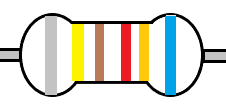
a = 8 (Gray) b = 4 (Yellow) c = 1 (Brown) n = 2 (Red) Tolerance = 5% (Golden) TCR = 10 (Blue) The value of resistance can be calculated as: abc×Multiplier±ToleranceTCR 841×102±5% TCR=84100Ohms±5% 10ppm 84.1KΩ±5% 10ppm Example 2: Consider the below resistor: 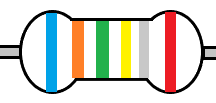
a = 6 (Blue) b = 3 (Orange) c = 5 (Green) n = 4 (Yellow) Tolerance = 10% (Silver) TCR = 50 (Red) The value of resistance can be calculated as: abc×Multiplier±ToleranceTCR 635×104±10% TCR=6350000Ohms±10% 50ppm 6.35MΩ±10% 50ppm
Next TopicAncient History MCQ
|
 For Videos Join Our Youtube Channel: Join Now
For Videos Join Our Youtube Channel: Join Now
Feedback
- Send your Feedback to [email protected]
Help Others, Please Share









